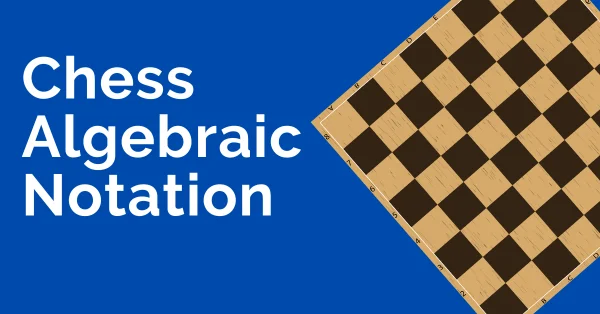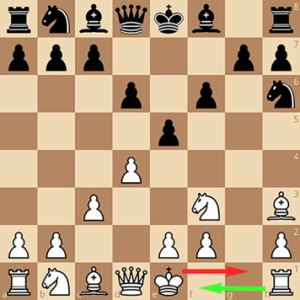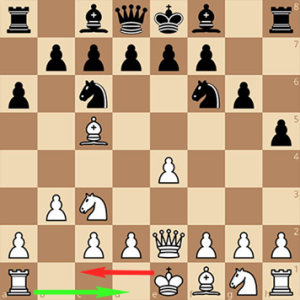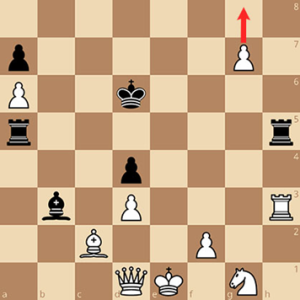Chess Algebraic Notation

Understanding chess algebraic notation is pivotal for professional chess players.
In today’s guide, you’ll not only grasp reading and writing chess notations but also delve into analyzing others’ games to refine your own skills.
Learning chess notation is a must-know for any ambitious chess player. It’ll allow you to read and write chess moves, spectate games and will take reading chess books to the next level.
Algebraic Chess Notation – How to Read and Write
Chess, a game of strategy, is widely known for its complexity and depth. Therefore, understanding how to read and write algebraic chess notation is a crucial skill for those who want to learn from their moves in chess and be able to replay them. Not to forget that it is required in competitive play!
Once you are finished reading this chess notation guide, you will finally be able to understand, read, and write algebraic chess notation and easily read tournament coverage or solve puzzles.
What is Algebraic Chess Notation?
Although the name may seem complex at first, algebraic chess notation is just the universal chess language. It is a simple and most accurate way to describe and write down moves on the board. This way chess players and chess fans can easily understand and study any game of chess.
The Pieces
Moves in chess algebraic notation consist of two different parts – the letter of the piece being moved and the destination square. Each of the pieces is represented by an uppercase letter. K stands for a king, Q for the queen, R for rook, N for knight, B for bishop, and no letter for pawn.
The destination square is indicated by the coordinates. So, if a pawn moves from h2 to h4, the destination square is notated h4. So, for example, if a bishop moves from c2 to f5, the move is recorded as Bf5.
Special Chess Annotations
There are certain chess notation symbols used to annotate specific positions or moves in notation. For example, “x” indicates a capture, “+” denotes a check, “#” signifies a checkmate, and “=” denotes pawn promotion.
In addition to that, castling is labeled by the letter “O”. So, if it is followed by either “O-O-O” for queenside castling or “O-O” for kingside castling.
Chess Notation Examples (Explained)
Understanding chess notation is much simpler when you have visual examples. In the following section, you will be able to see examples of algebraic chess notation along with pictures explaining them.
Long story short, before we begin, keep in mind that each piece is labeled by a letter except the pawn. If there is no capitalized letter at the beginning of chess notation, it’s assumed to be a pawn move.
King-Side Castling
In the following diagram, you will be able to see an example of king-side castling. The White king moves from e1 to g1 while the rook moves from h1 to f1. The chess notation for this move is “O-O”.

Queen-Side Castling
Queen-side castling is quite similar except for the fact that the king moves in the opposite direction, over the queen’s square. In other words, the king moves from e1 to c1 and the rook moves from a1 to d1. Queen-side castling is labeled “O-O-O”.

Pawn Promotion
Unlike other moves, when a pawn promotes, the piece it is promoted to is indicated at the end of chess notation. For instance, if a pawn on g7 moves to g8 and is promoted to a queen, the chess notation is g8Q.

How to Read Chess Moves
Learning to read chess notation involves interpreting the previously recorded moves to understand the progression of the game. In order to properly read chess moves, you need to familiarize yourself with chess notation symbols and chess coordinates.
Here are some chess notation examples you can practice on:
- f4 e5 – The White pawn moves to f4 square while the Black pawn moves to e5.
- g3 Qg5 – The White pawn moves to g3 square while the Black Queen moves to g5.
- Nf3 Qxg3+ – The White Knight moves to f3 square while the Black Queen takes the pawn on g3 and checks the White King.
How to Write Chess Moves
Once you have learned chess notation, writing chess moves is really a very simple thing. While noting down chess moves, one should only take note of all moves made during the game according to this format.
Begin with the piece’s name and then write the white move followed by that of black. Additionally; if there are any special annotations of chess, be sure to include them. When recording these movements it is important that everything is written clearly in order to make sure that they can be understood easily and without ambiguity.
Common Mistakes in Writing and Reading Chess Notation
Being patient and practicing is the key to learning chess notation quickly. Nevertheless, there are some mistakes that even advanced chess players tend to make while reading and writing down notation. Here are some of the most common ones:
- Confusion between pieces – Very often players make mistakes of labeling the knight with a “K” instead of the “N. Due to the silent “K”, the knight is always labeled “N”.
- Forgetting to record captures – It is crucial to always indicate the capture with the “X” symbol.
- Lack of clarity – Keep in mind that you will need the chess notation sheet filled clearly and legibly for post-game analysis.
- Forgetting special annotations – Always remember to write down special annotations such as pawn promotion, check, checkmate, etc.
- Order of notation – When noting down the moves made by both players, people tend to fail to record in the correct sequence. This could disrupt the flow of post-game analysis.
- Inconsistent style – Aim for the same format throughout the entire notation. You don’t want to consistently alter between ideas such as using “+” to indicate check and changing it to “check” later.
How to Make the Best Moves Using Algebraic Chess Notation
The first and most obvious way to get better at chess and identify more suitable moves is to learn algebraic notation for chess as much as possible. This will enable you not only to learn from your own games by replaying them later or on other boards but also to study professional players including grandmasters’ strategies through their games.










Comments: